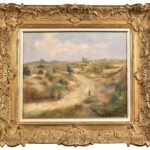At the end of the 19th century, France experienced a period of artistic boom, and one of the painters who managed to seize the charm of the epoch was Victor Vignon. Renowned for both his sensual rural landscapes, Vignon captured the silent beauty of the French countryside in works that echoed both Realism and Impressionism, making it a timeless one.
Childhood Influences and Creative Pathway
Victor Vignon was born in 1847 in Villers-Cotterets, where he was trained under Camille Corot and influenced by Camille Pissarro. The dual mentorship also assisted him in developing a style that can be described as a hybrid of the Barbizon School in its structural discipline and Impressionism with its lively spontaneity.
His style enabled him to portray nature as it was not only in reality, but in sensuousness, motion, and intense atmosphere.
The French Countryside As Seen by Vignon
The paintings by Victor Vignon frequently portray rural villages, fields, paths, and so on, covered in light diffraction. Instead of being overwhelmed by tumultuous, spectacular scenery, he was drawn to smaller, more personal pictures of nature, a group of cottages on a hill slope, a wavy road surrounded by trees, or peasants working in the field. His paintings make one feel like a canvassed visitor who has stumbled upon a picturesque corner of France that has escaped the Industrial Revolution.
The use of earthy, harmonious tones is one of the hallmarks of Vignon. His palette is dominated by ochres, warm browns and subdued greens to give it a natural warmth that attracts the spectator. His brushwork is neither too detailed nor too soft, but the forms are brought out softly on the canvas.
Exhibitions and Acclaim
Victor Vignon, less well known than other Impressionists, was a crucial figure in the movement. His paintings were represented at the Paris Salon and Impressionist shows and admired by artists and collectors alike. His work, combining modernism and rustic beauty, appeals to sensitive collectors and is highly sought after for its peaceful rendering of rural France.
The Continued Popularity of the Vignon Work
The paintings of Vignon can serve as a pause in the modern, fast-paced world. They are a reminder of the unchanging beauty of the daily life of the countryside, the snake-like road, the thatch of a cottage seen above a hedge, and the play of sunshine on a field. His landscapes are not mere landscapes; they are an invitation to enter into a more leisurely pace.
Both collectors and art historians still appreciate the technical fluency combined with emotional power that Vignon was able to achieve. His masterpieces are as emotional as they are rational, making them eternal in the history of French art.
Conclusion
To folks who are interested in fine work that incorporates the mood of impressionism as well as the down-to-earth elegance of the French countryside, the work of Victor Vignon can serve to be an inspiration even to this day. A selection of his paintings is on display at Leighton Fine Art and there is a selection which speaks a quiet, yet compelling story of rural France.

